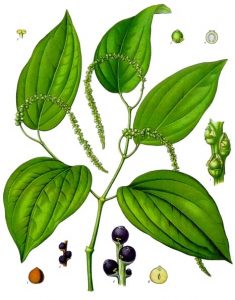 What is the first thing a person does when a plate of food arrives for consumption? Or after you fill your plate up when it’s “family” style? Reach for the salt and pepper, of course. Most people know where salt comes from, but pepper? What really is in that pepper mill or shaker? We were taught to shake it on our food, but why?
What is the first thing a person does when a plate of food arrives for consumption? Or after you fill your plate up when it’s “family” style? Reach for the salt and pepper, of course. Most people know where salt comes from, but pepper? What really is in that pepper mill or shaker? We were taught to shake it on our food, but why?
So here’s a little history about pepper and its uses.
Pepper is from India. South India to be exact. Pepper is harvested before it turns ripe and then goes through a process that transforms it into the little black pebbles that are then ground onto your salad.
Green peppercorns are the unripe berries of a vine from the Piperaceae family. They are treated to retain the green color. Black pepper is the same berry that has been soaked for a few days, then dried. The berries shrivel and take on the classic black color. White pepper is this same berry denuded. They are put through the same process of soaking that the black pepper goes through, then stripped of the outer skin revealing the white seed inside. Pink peppercorns aren’t true pepper as they come from the Peruvian Pepper tree found in Peru, a country on the South Americn continent. They are harvested and added to the classic four peppercorn mélange. Pink peppercorns are also used in the mignonette relish that is served with oysters on the half shell.
 Pepper has been valued since ancient times. I have been following the story of spices and how they got to our table. While pepper does not have such an illustrious past as nutmeg and clove, it has held high value throughout history from ancient to renaissance times. At one time it was known to be valuable currency.
Pepper has been valued since ancient times. I have been following the story of spices and how they got to our table. While pepper does not have such an illustrious past as nutmeg and clove, it has held high value throughout history from ancient to renaissance times. At one time it was known to be valuable currency.
Pepper was known to Egyptians, Romans, and the Greeks. The tiny little berries were priced beyond compare during medieval times. This lasted until the plant was transplanted and successfully grown in other regions, away from its native Kerala, India. Once in mass production and available on a global scale, pepper lost its value as currency, but had readily won its place at the dinner table, side by side with salt.
Some of the health benefits of Pepper include aiding in digestion and helping with ulcers. It is known as a carminative, which means it can help dispel gas in the digestive system. Pepper is a carrier, meaning it transports other healthy nutrients in your system to where they can do the most good. It has been used to treat respiratory disorders and has been shown to be beneficial in neurological studies, mainly with Alzheimer’s patients.
Pepper was used extensively in Ayurvedic practices to treat all these ailments and more. At one time it was used to treat vision problems, but how is lost to us today.
 So why doesn’t your common table pepper help with indigestion? It is usually adulterated (other ingredients added). As with most foods, pepper starts to lose its health value after being ground. For the full effect it is better to grind pepper right before using it. That way you get the full flavor and full health benefits. In higher end restaurants we take whole peppercorns, grind them in a spice grinder or blender, and then use the crushed pepper on your food.
So why doesn’t your common table pepper help with indigestion? It is usually adulterated (other ingredients added). As with most foods, pepper starts to lose its health value after being ground. For the full effect it is better to grind pepper right before using it. That way you get the full flavor and full health benefits. In higher end restaurants we take whole peppercorns, grind them in a spice grinder or blender, and then use the crushed pepper on your food.
Whether for food or health, using peppercorns instead of ground pepper is more beneficial. You can find pre-filled pepper mills or just get to the local specialty shop and purchase whole black pepper and grind or crush it yourself. Peppercorns don’t go bad, so don’t be afraid to grab that 16 ounce package on the shelf for refilling the pepper mill.
Here is a recipe for medieval black pepper sauce. I can’t lay claim to this one, nor have I tried it, but it could be fun to give it a try.







